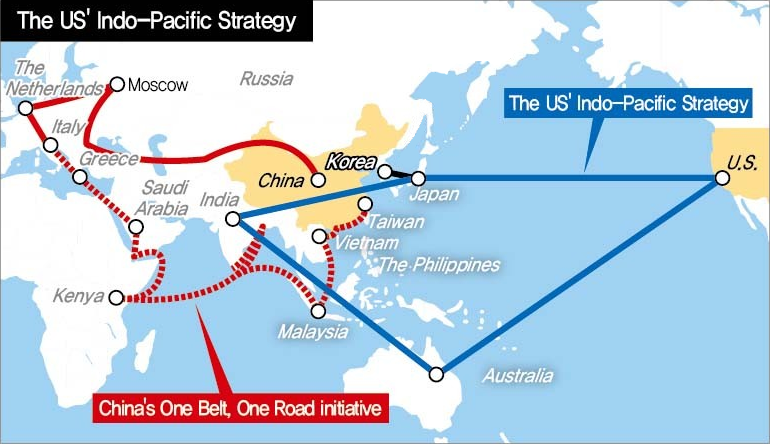US’ Indo-Pacific Strategy | 14 Feb 2022
For Prelims: US’ Indo-Pacific strategy, Indo-Pacific Region.
For Mains: Free and open Indo-Pacific, US’ Indo-Pacific strategy, Tackling China’s assertiveness, India’s Role.
Why in News?
Recently, the US administration has announced its long-awaited Indo-Pacific strategy.The document focuses on building collective capacity to deal with challenges in the region.
- These include a focus on challenges from China, advancing the US relationship, a ‘Major Defense Partnership’ with India and supporting its role as a net security provider in the region.
- There is an emphasis on working with other countries not just from the region, but also from beyond.
- Earlier, the European Union had announced that it will reinforce its strategic focus, presence and actions in the Indo-Pacific with the aim of contributing to the stability, security, prosperity and sustainable development of the region.
What are the Key Points of US’ Indo-Pacific strategy?
- Vision of Indo-Pacific: The US will seek an Indo-Pacific that is free and open, connected, prosperous, secure and resilient.
- Free: One of the strategic actions outlined is investing in civil society, a free press and democratic institutions.
- Connections: Within and beyond the region.
- The US says it will work “in flexible groupings” to tackle major issues, “particularly through the QUAD.”
- It will also deepen its (five) regional treaty alliances and work with groups such as ASEAN, the European Union (EU) and NATO.
- AUKUS, a security alliance between Australia, the UK and the US has also been recently launched.
- Prosperity: To advance its prosperity goal for the region, the US’ strategy includes seeking higher labour and environmental standards, helping to establish secure supply chains and investing in clean energy.
- Security: The US has announced that “Integrated deterrence” will form the “cornerstone” of the US’ security plan for the region.
- It will drive initiatives that reinforce deterrence and counter coercion, such as opposing efforts to alter territorial boundaries or undermine the rights of sovereign nations at sea.
- Resilience: The Indo-Pacific faces major transnational challenges.
- Climate change is growing ever-more severe as South Asia’s glaciers melt and the Pacific Islands battle existential rises in sea levels.
- Further,the Indo-Pacific governments grapple with natural disasters, resource scarcity, internal conflict, and governance challenges.
- In this context, US envisages to build regional resilience to 21st century transnational threats, including by:
- Working with allies and partners to develop 2030 and 2050 targets, strategies, plans, and policies consistent with limiting global temperature increase to 1.5 degrees Celsius.
- Reducing regional vulnerability to the impacts of climate change and environmental degradation.
- Role of India: India’s role in the QUAD is an important element of the US-India relationship.
- US will “continue to support India’s rise and regional leadership,” working with India bilaterally and through groups on a range of issues.
- It refers to India as a “like-minded partner” and “driving force” in the QUAD.
- China's action along the Line of Actual Control (i.e., its border conflict with India) has had a “galvanizing impact” on India and US alignment.
- Collaborate in new domains, such as health, space, and cyberspace, deepen economic and technology cooperation, and contribute to a free and open Indo-Pacific.
- China’s Assertiveness: US allies and partners in the region bear much of the effect of China’s assertive policies.
- The economic coercion of Australia.
- The conflict along the Line of Actual Control with India.
- The growing pressure on Taiwan.
- Bullying of Japan, ASEAN countries in the East and South China Seas.

